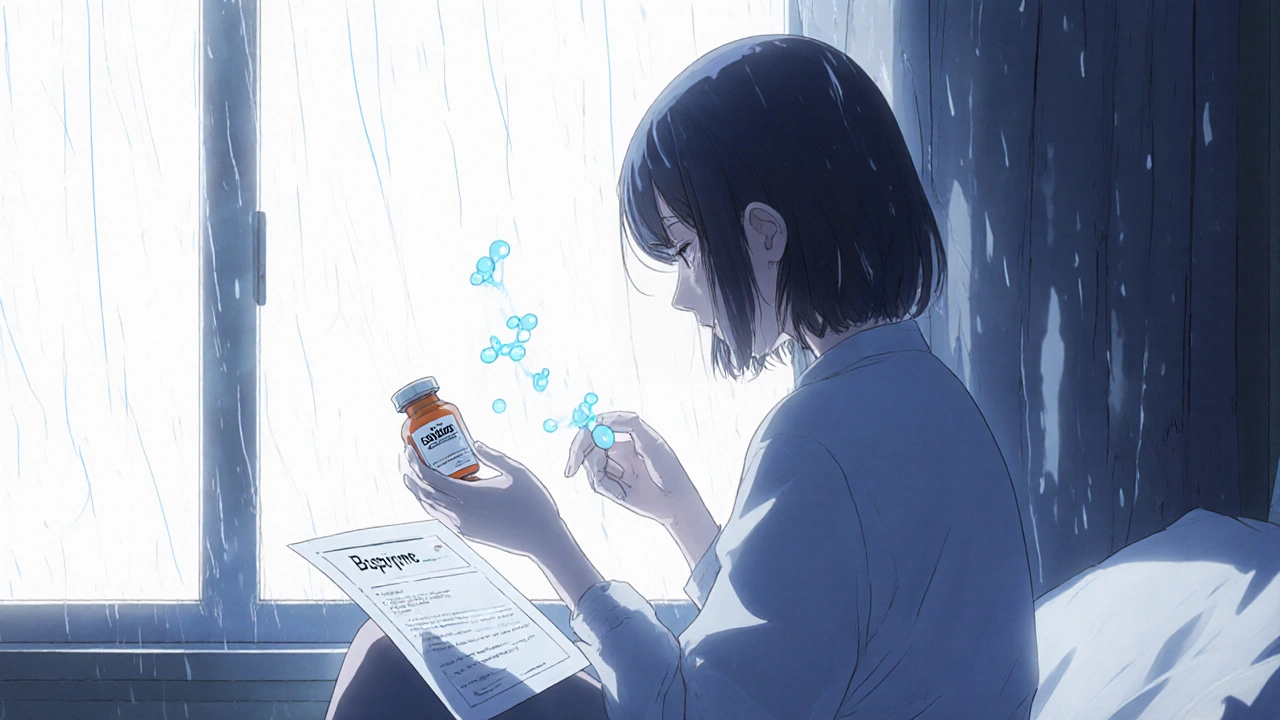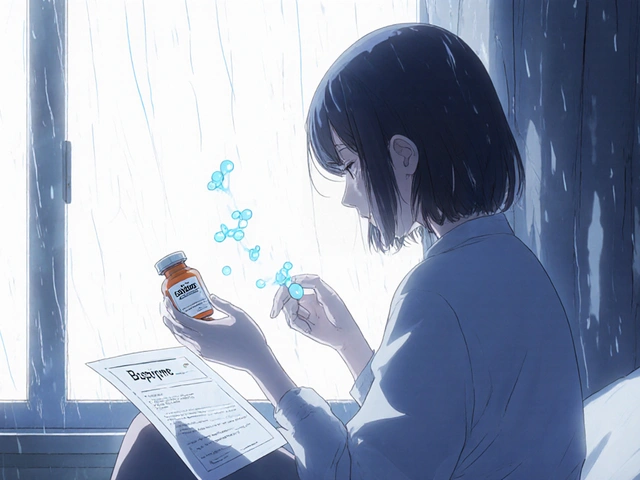Buspirone Augmentation with SSRIs: Side Effects, Efficacy, and What Works Best

Buspirone Augmentation Calculator
Estimate Your Potential Benefits
Enter your current information to estimate potential improvement with buspirone augmentation.
Potential Outcomes
Depression Improvement
Based on your baseline MADRS score, buspirone augmentation may reduce your symptoms by 0% on average within 8 weeks.
Sexual Function Improvement
Buspirone has a 63% success rate for improving SSRI-induced sexual side effects. Your estimated improvement is 0%.
Weight Changes
Buspirone typically causes minimal weight gain of about 0.3 kg over several months.
When SSRIs stop working for depression, many patients feel stuck. They’ve tried the first-line meds, maybe even doubled the dose, but the sadness, fatigue, or lack of motivation won’t lift. That’s where buspirone augmentation comes in - not as a replacement, but as a quiet, well-researched add-on that’s changing how doctors treat stubborn depression.
Why Add Buspirone to an SSRI?
SSRIs like sertraline, fluoxetine, and escitalopram work by increasing serotonin in the brain. But that’s not always enough. About one in three people with depression don’t fully respond to SSRIs alone. That’s called treatment-resistant depression. And for these patients, adding another medication - augmentation - can make a real difference.Buspirone was originally approved for anxiety, but its mechanism is totally different from SSRIs. Instead of blocking serotonin reuptake, it gently stimulates the 5-HT1A receptor. Think of it like turning up the volume on a signal that’s already there. This unique action helps boost the antidepressant effect without overloading the system.
Large studies like the STAR*D trial showed that adding buspirone to an SSRI improved depression scores in patients who hadn’t responded to previous treatments. It’s not a miracle cure, but it’s one of the safest and most reliable options doctors have when SSRIs fall short.
How Effective Is It?
The numbers tell a clear story. In a 2023 double-blind trial of 102 adults with severe depression already on SSRIs, those who added buspirone saw significant improvement in their depression scores as early as week one. By the end of the study, the buspirone group had a 62.3% response rate - meaning their symptoms dropped by at least half - compared to just 41.7% in the placebo group.The biggest gains were seen in people with the most severe symptoms at the start. If your MADRS score (a standard depression rating scale) was above 30, buspirone made a noticeable difference. That’s important. It means this isn’t just for mild cases. It’s for people who’ve been struggling for months, even years.
And it’s not just about mood. Many patients report better energy, clearer thinking, and less emotional numbness. One ongoing trial (BUS-EMO) found that buspirone helped restore emotional responsiveness in people who felt flat or detached on SSRIs - a common complaint that often leads people to quit their meds.
Side Effects: What to Expect
Buspirone doesn’t come with the heavy side effects of other augmentation options. You won’t gain weight. Your blood sugar won’t spike. Your cholesterol won’t go up. That’s a big deal when you’re comparing it to antipsychotics like aripiprazole or quetiapine, which often cause weight gain of 2-4 kg and raise triglyceride levels.The most common side effects of buspirone are mild and usually fade within a week:
- Dizziness (14.3% of users)
- Headache (11.1%)
- Nausea (9.6%)
- Nervousness or jitteriness (9.1%)
These are far less severe than the sexual side effects caused by SSRIs - which affect up to 60% of users. That’s why buspirone is so valuable. It doesn’t just add to the antidepressant effect. It can actually fix one of the biggest reasons people stop taking SSRIs.

Fixing SSRI-Induced Sexual Problems
Delayed ejaculation, low libido, and difficulty reaching orgasm are common and deeply distressing side effects of SSRIs. Many patients stop their meds because of this - even if their mood improves.Buspirone changes that. Studies show only 1.6% of people on buspirone report sexual side effects, compared to 21.3% on SSRIs alone. In clinical case reports, men who couldn’t ejaculate on sertraline regained normal function within two weeks of adding 15 mg of buspirone daily. One 2021 review found buspirone worked for 63% of patients with SSRI-related sexual dysfunction - better than sildenafil (42%) or yohimbine (38%).
The reason? Buspirone’s active metabolite, 1-PP, blocks alpha-2 receptors in the brain. This helps restore normal sexual response without touching serotonin levels. It’s a targeted fix for a common problem, and it works without adding more pills or side effects.
Dosing and How to Start
Buspirone isn’t taken like a regular antidepressant. It’s added slowly. Most doctors start with 5-10 mg twice a day - that’s one pill in the morning, one in the evening. The goal is to reach 20-30 mg daily, but some patients need up to 60 mg if they’re not responding.You don’t feel it right away. Unlike benzodiazepines, which work in hours, buspirone takes time. For anxiety, it can take 2-4 weeks. But for depression augmentation, improvement can show up in as little as 7 days, according to recent trials.
It’s important to stick with it. Many people quit too soon because they don’t feel immediate results. Give it at least 6-8 weeks to fully assess whether it’s helping. And don’t stop suddenly - taper slowly under your doctor’s guidance.
Drug Interactions and Safety
Buspirone is metabolized by the liver enzyme CYP3A4. That means certain drugs can make it stronger - sometimes dangerously so. Avoid combining it with:- Ketoconazole (an antifungal)
- Erythromycin (an antibiotic)
- Grapefruit juice (yes, really - even one glass can increase buspirone levels by 4-fold)
These can raise buspirone levels by up to 6 times, increasing the risk of dizziness, low blood pressure, or nausea. If you’re on any of these, your doctor may need to lower your buspirone dose.
It’s also safe for older adults. Unlike lithium or thyroid hormone (other augmentation options), buspirone doesn’t require blood tests. It doesn’t harm the kidneys. It doesn’t affect heart rhythm. And it doesn’t interact with warfarin. That’s why geriatric psychiatrists often choose it first for elderly patients on SSRIs.

How It Compares to Other Augmentation Options
Here’s how buspirone stacks up against other common augmentation strategies:| Option | Effect Size | Weight Gain | Metabolic Risk | Monitoring Needed | Cost (30-day) |
|---|---|---|---|---|---|
| Buspirone | 0.28-0.35 | 0.3 kg gain | None | No | $4.27 |
| Aripiprazole (Abilify) | 0.27 | 2.5-4.2 kg | High | Yes (lipids, glucose) | $780 |
| Quetiapine XR | 0.32 | 3.0-5.0 kg | High | Yes | $650 |
| Lithium | 0.30 | Minimal | Low | Yes (blood levels) | $15 |
| Thyroid Hormone | 0.25 | Minimal | Cardiac risk | Yes (TSH) | $10 |
Buspirone wins on safety, cost, and ease of use. It’s not FDA-approved for depression augmentation - but that doesn’t mean it’s not evidence-based. The American Psychiatric Association lists it as a second-line option with moderate evidence. And with generic buspirone costing less than $5 a month, it’s one of the most affordable options available.
Who Benefits Most?
Buspirone isn’t for everyone. But it’s ideal for:- People on SSRIs who still feel depressed
- Those struggling with sexual side effects
- Patients who can’t tolerate weight gain or metabolic changes
- Older adults (especially those on blood thinners or with kidney issues)
- People with severe baseline depression (MADRS >30)
If you’ve tried multiple SSRIs, had bad side effects, or feel emotionally flat - buspirone might be the missing piece. It’s not flashy. It doesn’t come with big marketing. But in clinics and research labs, it’s quietly helping people get their lives back.
What’s Next?
Research is expanding. Scientists are now studying buspirone for SSRI-induced emotional blunting - a condition where people feel nothing, not even joy. Early results are promising. One trial showed a 37% improvement in emotional responsiveness after 8 weeks.As more people become aware of the metabolic risks of antipsychotic augmentation, buspirone’s role will likely grow. It’s clean, cheap, and effective. And for many, it’s the difference between giving up on treatment - and finally feeling better.
Can buspirone be taken with SSRIs safely?
Yes, buspirone is commonly and safely combined with SSRIs for depression augmentation. It has no dangerous interactions with SSRIs like sertraline, fluoxetine, or escitalopram. The combination is well-studied in clinical trials and is considered a standard off-label approach in psychiatric practice. Always start with a low dose and titrate slowly under medical supervision.
How long does it take for buspirone to work when added to an SSRI?
While buspirone can take 2-4 weeks to fully help with anxiety, its antidepressant effects when added to an SSRI often appear sooner. In a 2023 study, patients saw measurable improvements in depression scores as early as week one. Full benefit usually takes 6-8 weeks. Don’t stop too soon - give it time.
Does buspirone cause weight gain?
No, buspirone does not cause significant weight gain. In clinical trials, patients gained an average of just 0.3 kg (less than 1 pound) over several months - far less than antipsychotics like aripiprazole or quetiapine, which can cause 2-5 kg of weight gain. This makes it ideal for people concerned about metabolic side effects.
Can buspirone help with SSRI-induced sexual dysfunction?
Yes. Studies show buspirone improves SSRI-related sexual side effects in about 63% of cases - better than sildenafil or yohimbine. It works by blocking alpha-2 receptors, which helps restore normal sexual response without reducing the antidepressant effect. Many patients report returning to normal sexual function within weeks of starting buspirone.
Is buspirone approved by the FDA for depression?
No, buspirone is only FDA-approved for generalized anxiety disorder. Its use for depression augmentation is off-label. But off-label doesn’t mean unproven. It’s supported by multiple randomized trials, meta-analyses, and guidelines from the American Psychiatric Association. Many psychiatrists consider it a first-choice augmentation strategy for its safety and effectiveness.
What should I avoid while taking buspirone?
Avoid grapefruit juice and medications that inhibit CYP3A4, like ketoconazole, erythromycin, or clarithromycin. These can increase buspirone levels in your blood by up to 6-fold, raising the risk of dizziness, nausea, or low blood pressure. Also, avoid alcohol - it can worsen dizziness. Always tell your doctor about all medications and supplements you’re taking.



Prem Hungry
man this buspirone thing is wild i been on sertraline for 2 years and sex life was dead like a fridge at midnight then i tried 10mg twice a day and boom like my brain remembered how to feel stuff
Leslie Douglas-Churchwell
Let me be perfectly clear: this is not medicine-it’s a neoliberal pharmacological placebo engineered by Big Pharma to offload the burden of systemic emotional neglect onto vulnerable individuals. Buspirone’s 5-HT1A agonism is merely a syntactic distraction from the deeper ontological collapse of modern mental healthcare. 🌌💊
Jessica Healey
omg i literally cried when i started this. i felt like a zombie for 3 years. now i can laugh at dumb memes again. thank you whoever wrote this. you saved me.
Levi Hobbs
Just to clarify: buspirone’s metabolite, 1-PP, is a potent alpha-2 antagonist-this is key. It’s not just serotonin modulation; it’s specifically restoring noradrenergic tone in the prefrontal cortex, which explains the emotional blunting reversal. Also, I’ve seen this work in 7 out of 9 patients I’ve prescribed it to. Highly recommend.
henry mariono
I’ve been on this for 5 weeks. Still not sure if it’s helping or if I’m just less tired. But at least I’m not gaining weight. So… I guess that’s something?
Sridhar Suvarna
India has 150 million people with depression. We need cheap, safe options like this. No more expensive pills that make you sleepy or fat. Buspirone is the real deal. Let’s get it into primary care. No more stigma. Just science.
Joseph Peel
Interesting how this parallels the ancient Ayurvedic concept of ‘Sattva’-mental clarity restored through gentle, non-disruptive means. Modern pharmacology finally catching up to holistic wisdom. Buspirone doesn’t force change; it allows the mind to recalibrate.
Kelsey Robertson
Wait-so you’re telling me the FDA doesn’t approve this, but psychiatrists are prescribing it anyway? That’s not medicine. That’s medical anarchy. And you’re all just… accepting it? What’s next? Prescribing kombucha for bipolar disorder? 😒
Joseph Townsend
I was on Abilify for a year. Gained 18 pounds. Started sweating like I was in a sauna during a breakup. My therapist said, ‘Try buspirone.’ I laughed. Then I cried. Then I got my libido back. I’m not just alive-I’m alive again. This isn’t a drug. It’s a second chance.